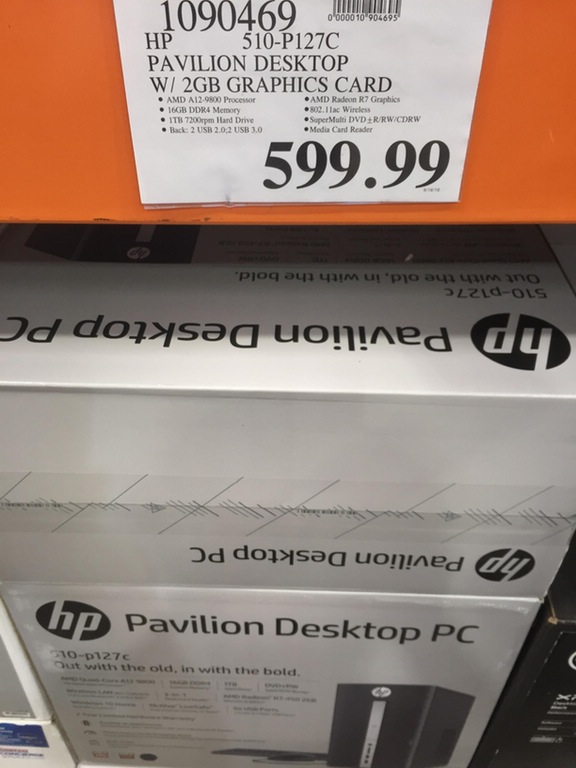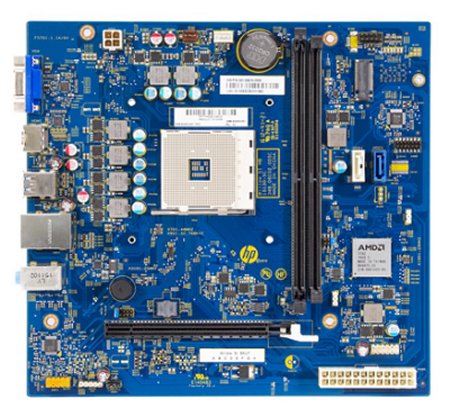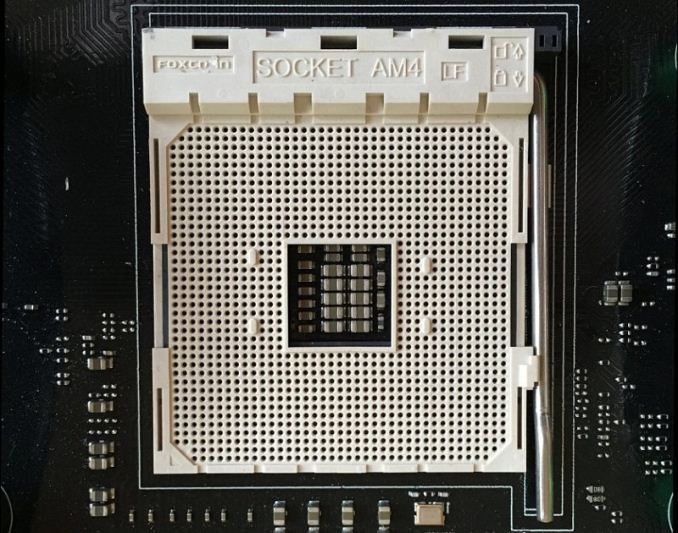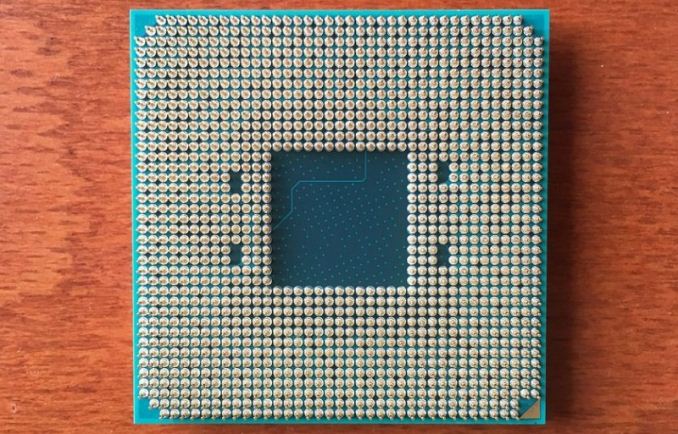AMD 7th Gen Bristol Ridge and AM4 Analysis: Up to A12-9800, B350/A320 Chipset, OEMs first, PIBs Later
by Ian Cutress on September 23, 2016 9:00 AM ESTMotherboards, Sockets, Pins and Things
As an OEM only launch, details about exact systems coming to market (and how they are designed) is providing slim pickings. With a normal retail launch, we have several motherboard manufacturers to dig our teeth into when asking questions, however our relationships with the major OEMs such as HP, Dell or Lenovo are quite different and typically more product focused and less engineering. We’ve not seen any real Bristol Ridge related announcements on OEM systems coming into the market, but some do exist. Reddit user starlightmica saw this HP Pavilion 510-p127c in Costco this week:
$600 gets an A12-9800, 16GB of DDR4, a 1TB mechanical drive, an additional R7 2GB graphics card, 802.11ac WiFi, a DVDRW drive, and a smattering of USB ports (but no USB 3.1, which is interesting).
We reached out to HP, as this system was listed online with the blurriest of motherboard images.
This is a ‘Willow’ motherboard, and we can see the AM4 socket in the middle. Contrary to previous platforms, it is worth noting that the socket mounting holes are significantly more ‘square’ than previous motherboard designs. However, when we discussed the images of the South Korean overclocker near the beginning of this article, it looked like he was using a standard AMD Wraith cooler, which might suggest that this square mounting hole situation might just be HP designing the motherboard.
The board clearly has six phases as part of the power delivery, plus an additional phase for the memory. I would assume that since the system has dual channel support, HP has developed the two memory slots as having dual channel capability, and the abundance of traces from the APU seems to suggest that as well.
To the right of the DRAM slots seems to be a PCIe x1 slot, which is where I assume the WiFi module is held. Below this slot are two of the system SATA ports, followed by what looks like a chipset with a big AMD logo on it and then the 24-pin power connector.
The motherboard has a full PCIe 3.0 x16 sized slot, although as we discussed before, this will be limited to PCIe 3.0 x8 due to the design of the processor. To the left of this is clearly a Realtek audio codec, and judging by the 2.1 support on the rear panel, this is most likely an ALC269 or some other low-end codec. It is hard to tell where the network controller is here without the high-resolution image, but just above and to the left of the speaker looks like a small IC which looks similar to Realtek’s low-end solutions. Typically Realtek offers a deal when audio+networking chips are used in the same system, so I suspect that is what is happening here. Above this are our USB ports, an HDMI output, and a VGA port which must be using a DP-to-VGA IC onboard.
We have closer up images of the socket, thanks to the Hungarian website hwsw:
This looks like the standard ZIF socket we’ve come to love/loathe from AMD (I doubt there’s a way that keeps everyone happy anyway), and others have counted 1331 holes which may/may not do things.
The rear of the CPU, also from hwsw, is what we would expect given the socket layout. It does mean that AMD is stuck at this level of connectivity, to anyone wishing for a quad-channel AMD platform suitable for consumers will have to wait until a future platform. It’s also worth noting that this looks like a similar size to when AMD CEO Lisa Su held up a Zen chip for the press back at the Zen announcements in August.
What Happens Now
Aside from spotting systems like the HP in Costco, no doubt a number of media outlets (us included) are trying to get hold of a number of the APUs for official reviews. As mentioned previously, that A12-9800 looks like an exciting all round part. We are working with AMD to secure the platform and the APUs for testing.
AMD has told us that Bristol Ridge APUs are designed to have price parity with the current Kaveri Refresh/Godavari models, however exact configurations of APUs and coolers, as well as a timeframe for the motherboard manufacturers to come out with their designs, is still to be decided.
I suspect that AMD will wait until closer to the Zen launch window to put Bristol Ridge on the shelves. Attacking the market with a new platform that goes from the high-end desktop through to all but the cheapest systems would mean a concerted effort to gain market share and recognition for catering to the performance needs of as many users as possible all at once. AMD has promised that Zen will trickle down the stack, however as we were told regarding their server and laptop plans later in 2017, that will mostly likely occur later in the year also.
If you’ve read through this piece, or merely skipped to the last page for the conclusions, here’s the take away from the Bristol Ridge for desktop launch:
- OEMs first, DIY builds later
- The A12 at 65W has better specifications than the best previous generation A10 at 95W
- Even at 65W, there is +30% frequency on the integrated graphics for the A12-9800
- The chipsets support USB 3.1 (10 Gbps) natively, but Type-C requires a small additional chip
- Bristol Ridge is more like an SoC, the chipset is entirely optional
- There are so many fun things you can do with PCIe and switches
- We expect the retail APUs to be price drop-ins for current APUs
- We’re trying to get these APUs for review. Stay tuned.





















122 Comments
View All Comments
patrickjp93 - Tuesday, September 27, 2016 - link
Yeah, no. Even the 5775C has thoroughly beaten everything AMD has so far offered, even if narrowly. Skylake GT3e increased that gap, and GT4e dug a canyon between Intel and AMD. This is why I sincerely doubt AMD's HPC APUs will get much traction.MrCommunistGen - Tuesday, September 27, 2016 - link
Skylake's GT4e really is in a whole new league of iGPU performance (at a significant cost) - but to nitpick GT3e on Skylake very likely underperforms GT3e on Broadwell.Broadwell GT3e (specifically Iris Pro 6200) is 48EUs at up to 1150MHz backed by 128MB eDRAM on a 65W TDP quad core.
Skylake GT3e (specifically Iris Graphics 550) is 48EUs at up to 1100MHz backed by 64MB eDRAM on a 28W dual core. (I'm not counting the listing for the "Server" GT3e which is listed as P555 with 128MB)
Skylake has microarchitecture improvements to both the EUs and to the x86 cores. It also supports DDR4 and Gen9 includes delta compression - so the iGPU undoubtedly has more bandwidth available.
That said, I really think that the smaller eDRAM, lower TDP, and lower max clock speed will make SKL GT3e slower than BDW GT3e.
Due to the rearrangement of SKUs and iGPUs in SKL I think this is all natural. Intel is trying to *significantly* increase the iGPU perf available to their 15/28W dual core CPUs with its iteration of GT3e, however this allows for the potential that this architecture's GT3e underperforms the previous.
Danvelopment - Saturday, September 24, 2016 - link
Something seems a bit funny about the IGPs of the A8 and A6. The A8 states R7 with 384SPs and a lower clock than the R5 in the A6 also with 384SPs.Should the A6 be R7 or 256 SPs? And if it's correct, how does the IGP compare between the two? And what makes the A8 faster?
Danvelopment - Saturday, September 24, 2016 - link
Also, any chance in getting a couple R5 performance indicators?MrCommunistGen - Tuesday, September 27, 2016 - link
I noticed that too. I've seen tables and slides from various sites and they all list those specs. The only thing I can conclude is that since the A6 has half the CPU resources, maybe AMD just assumes that for most tasks you'll end up CPU bound to a large enough degree that even thought the iGPU is technically faster, performance will be lower.Or... the alternative is that there's a typo of some sort in the original materials published by AMD.
yannigr2 - Saturday, September 24, 2016 - link
Oh, really nice article. Thanks for this.Well the first Zen processors will probably cost more than the A12. Then when Zen based APUs will be ready to come to the market, we will see and smaller Zen models.
ET - Saturday, September 24, 2016 - link
Thanks for the writeup, Ian. I even learned some new things which I haven't yet read elsewhere. I do hope that Anandtech can get its hands on a chip for reviews.NeatOman - Sunday, September 25, 2016 - link
Marginal improvement IMO over last gen APU's. Looks interesting but an i3 will still "feel" faster as its single core power is still greater, although i almost always build AMD APU's for small offices because Microcenter has a instant $40 rebate when you buy in store. BUT.. ZEN SoC with HBM might be a game changer (to quote 2014), and rumor is Apple is eyeballing it for the next Macbook Pro. And AMD has a good track record on Unix based OS's which might be why the Mac Pro uses AMD... I'm going down a rabbit hole. SOO! A12... ehh.. no significant change but I'm waiting for ZEN.utroz - Sunday, September 25, 2016 - link
Ian Cutress on the first page you say: "Using the updated 28nm process from TSMC, AMD was able to tweak the microarchitecture and allow full on APUs for desktops using a similar design."Problem is that Carrizo and Bristol Ridge are actually made at Global Foundries on a 28nm process.
TheinsanegamerN - Monday, September 26, 2016 - link
"Back at Computex, AMD announced the thing to fill that hole: Bristol Ridge (and Stoney Ridge by extension). This is what AMD will call and market it's '7th Generation' of APUs, and will be built on TSMC's 28nm Bulk CMOS process."From anandtech's look at carrizo in july. Everything else i've found doesnt say GF or TSMC, just 28nm.
so far, evidence is pointing at TSMC, not GF.